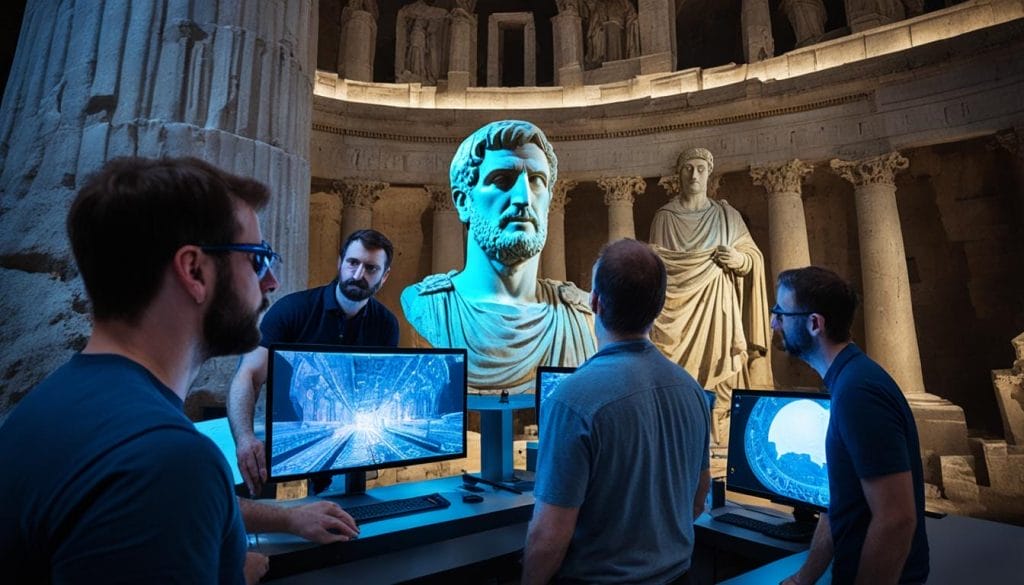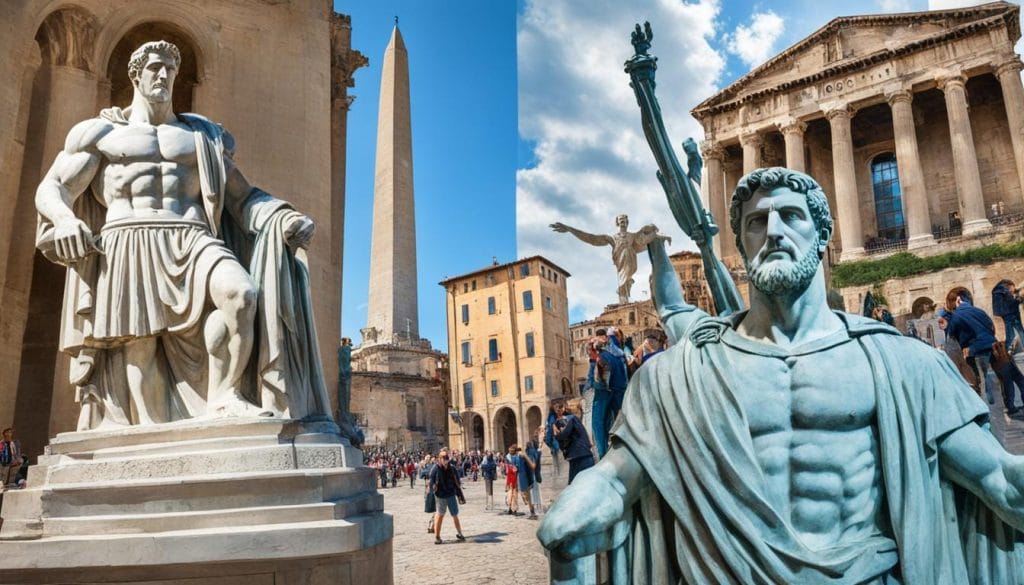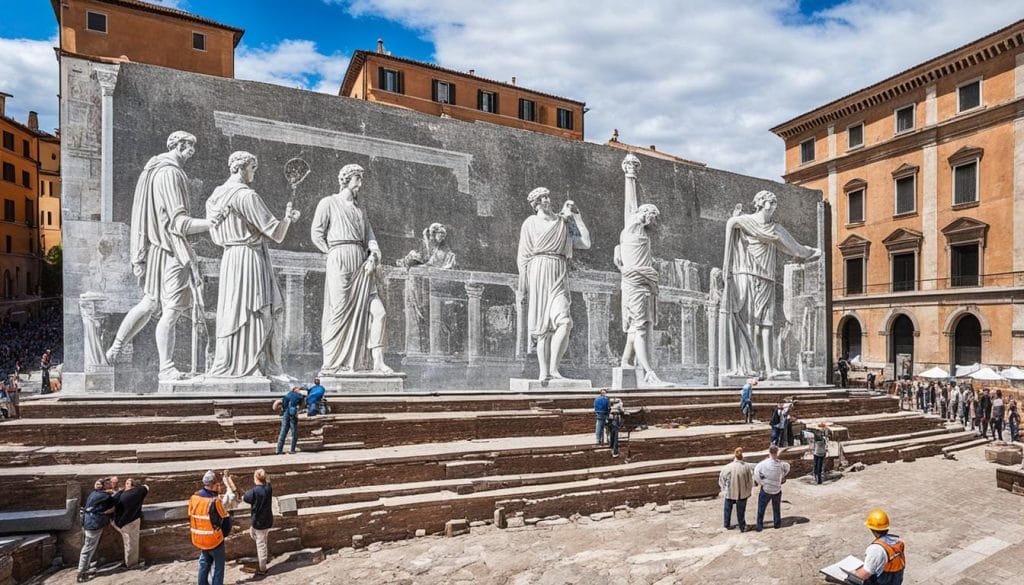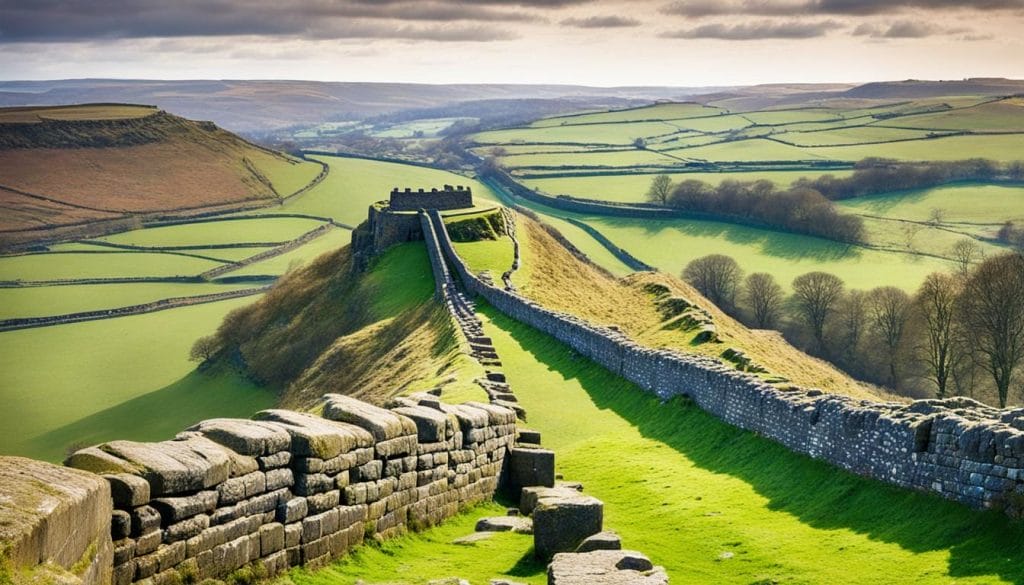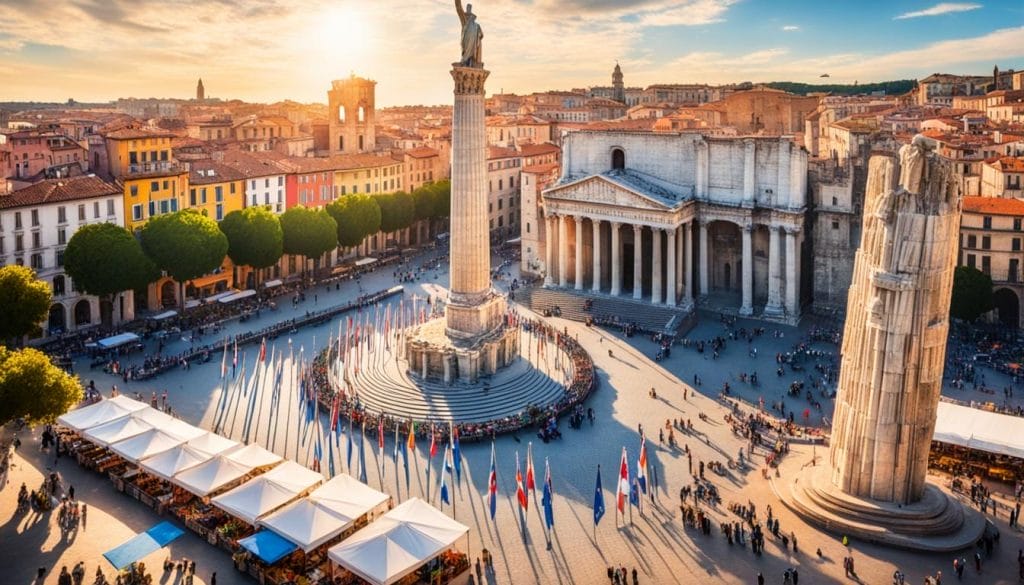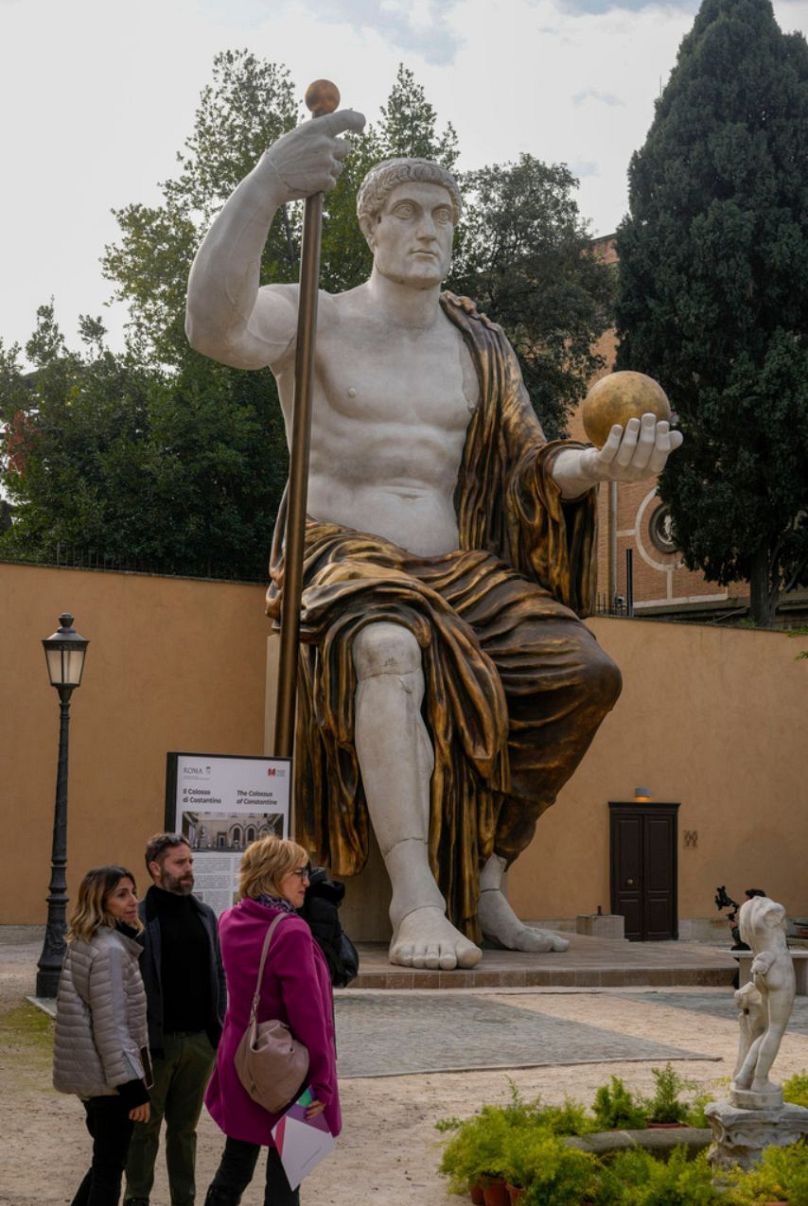
We explore the remarkable resurrection of the Colossus of Constantine, a treasure of Ancient Rome. Set against the backdrop of the historic Capitoline Museums, this awe-inspiring endeavor merges antiquity and modern ingenuity. Through the meticulous process of statue reconstruction, the grandeur of Constantine the Great’s likeness has been brought back to its former glory, thanks to the precision of 3D modeling technology. This project is not just a restoration of a historical landmark; it represents a bridge connecting Rome’s imperial past to the pulse of our present-day world.
Let’s dive into the fascinating details of how this ancient masterpiece was pieced back together, creating a beacon that illuminates the greatness of Constantine the Great and offers a tactile experience of Rome’s storied history. Through this journey, you’ll discover how historical landmarks are being reinterpreted for future generations, offering a tangible encounter with the world of our ancestors.
Key Takeaways
- Discover the fusion of Ancient Rome and advanced 3D modeling technology in reconstructing historical landmarks.
- Understand how the Capitoline Museums have become the custodian for Constantine the Great’s rich legacy.
- Gain insights into the intersection of history, art, and technology through the statue reconstruction process.
- Appreciate the role of cultural preservation in bridging the gap between past civilizations and modern society.
- Uncover the significance of the Colossus of Constantine and its contemporary resonance as a symbol of ancient imperial power.
Emperor Constantine’s Legacy and the Original Colossus
Reflecting on the indelible impact of Emperor Constantine, known as the first Christian emperor of the Roman Empire, one cannot overlook the religious and cultural transformation during the 4th century. The Christian faith flourished through his endorsement, recalibrating the spiritual compass of a vast empire and etching his theological and political outlook into history. This legacy was symbolically encapsulated within the form of an immense acrolithic statue, looming over the Forum Romanum with a silent assertion of divine and imperial authority.
The Historical Significance of Constantine’s Reign
Amidst a backdrop of political intrigue and societal shift, Constantine emerged as a central figure of the Roman Empire’s evolution. By embracing the Christian faith, he not only transformed his own fate but also redefined the religious landscape of an empire spanning three continents. Constantine’s embrace of Christianity, a once persecuted belief system, and the consequent Edict of Milan in 313 AD, which granted religious tolerance throughout the empire, was revolutionary. His reign signifies a pivotal junction where traditional Roman paganism and the burgeoning Christian church collided, reshaping the future of Europe and Western civilization.
Details of the Original Colossus of Constantine
In the burgeoning heart of Rome, the Basilica of Maxentius once housed a statue that stood as an emblem of Constantine’s undisputed dominion. This acrolithic statue, a marvel of ancient engineering, skillfully combined various materials to achieve its monumental stature. Employing luxurious white marble for the visage and extremities, the statue’s core and limbs were an intricate assemblage of brick and wood, possibly enveloped in sheets of gilded bronze. The colossal structure, soaring to a height of nearly 40 feet, was crowned by the intricate marble head of Constantine, a testament to the craftsmanship of the era.
- Statue Height: Approximately 40 feet
- Marble Head: Measuring roughly 2.5 meters
- Construction: White marble combined with a brick core and wooden framework
- Ornamentation: Possible gilded bronze adornments
- Location: Basilica of Maxentius, Forum Romanum
The statue’s raised right hand, a gesture rich with symbolic weight, may have once held an object of powerful Christian iconography, perhaps a sign of Constantine’s dedication to his newly embraced faith. This mighty acrolith, now fragmented by the relentless march of time, stood not only as an architectural landmark but also as a beacon of Constantine’s enduring legacy – a tangible connection between the realm of mortals and the divine.
Discovering the Fragmented Marvel in Modern Rome
The journey to piece together one of Rome’s most significant historical relics began with an archeological discovery that still resonates with us today. Amidst the ruins of antiquity, the fragmented remnants of a past civilization were unearthed, bringing the legacy of a bygone era back to the forefront of cultural consciousness. The spotlight falls on the esteemed Capitoline Hill, where the enduring echo of history is more than just stone and memory—it’s a living testament to the grandeur of Ancient Rome.
Within the heart of Rome, marble fragments that were once part of an imperial icon have been carefully preserved. These relics, scattered pieces of the majestic Colossus of Constantine, were rediscovered, demanding immediate and meticulous preservation efforts. Let’s delve into the excavation and preservation processes that have safeguarded these invaluable artifacts for future generations.
Excavation and Preservation of Constantine’s Statue Parts
In the year 1486, Renaissance explorers stumbled upon the colossal marble fragments within the ruins of ancient buildings. This discovery on the Capitoline Hill ignited a flame of interest in Rome’s imperial past. The fascination with these artifacts was not solely for their aesthetic prowess but also for their representation of Rome’s indelible mark on world history. The fragments—comprising the head, limbs, and partial elements of the once towering Colossus of Constantine—now reside within the protective arms of the Palazzo dei Conservatori’s courtyard.
The commitment to preservation has ensured that these marble fragments remain not only a vestige of Rome’s illustrious lineage but also an accessible piece of history for all. At the turn of the millennium, significant restoration undertakings were carried out, cementing the foundation for these relics to stand the test of time. It is here that the excavation process transformed into one of conservation, weaving together the narrative of Constantine’s fragmented marvel with the threads of modern-day Rome.
| Element | Description | Significance |
|---|---|---|
| Massive Head | One of the most striking parts, showcasing intricate facial features | Embodying the power and authority of Emperor Constantine |
| Limbs | Fractured yet significant remains of the statue’s hands and feet | Displaying the craftsmanship and artistry of early 4th-century sculptors |
| Partial Elements | Assorted fragments encompassing various parts of the statue | Providing insight into the original structure and scale of the Colossus of Constantine |
In the shadow of the past, the footsteps of the future resonate with purpose and persistence. As we continue to explore the depths of Rome’s rich tapestry, the fragments of Constantine’s statue serve as pillars of our shared heritage—a story of resilience and awe that is carried forward with each marble piece we strive to protect.
Technological Marvels: How 3D Modeling Reconstructed the Ancient Statue
The advent of digital reconstruction methodologies has offered new frontiers in the preservation of our cultural patrimony. The Factum Foundation, renowned for its dedication to blending art with technology, has leveraged 3D laser scanning to transform the way we view historical conservation and education. This synergy of discipline and innovation is a testament to the profound impact digital technology in preservation has in immortalizing our collective past.
Factum Foundation’s approach involved intricate 3D laser scanning of the original marble fragments of the Colossus of Constantine, capturing every minute detail contained within the ancient textures. These detailed scans were then used to create a digital model that served as the blueprint for the statue’s reconstruction. This digital avatar, a mesh of millions of data points, allowed for a reconstruction that was as true to the original as possible.
- Data Capturing: Meticulous 3D scanning ensures no detail is missed.
- Digital Modelling: The transformation of scan data into a structured digital model.
- Prototyping: Utilizing the model to create small-scale prototypes for review.
- Scaling: Translation of prototypes to life-size proportions.
- Material Consideration: Selection of appropriate materials for the final output.
- Final Assembly: The life-sized pieces are carefully constructed to form the final statue.
The use of digital technology in the field of historical preservation not only safeguards our cultural heritage but also enables an unparalleled level of precision and fidelity in the reconstruction of ancient artifacts.—Factum Foundation
In showcasing the modern reincarnation of Roman splendor through digital reconstruction, the Factum Foundation further promotes educational opportunities. These digital methodologies enable scholars and the public alike to delve deeper into historical contexts and foster a more profound appreciation for the artistic and engineering feats of our ancestors.
| Original | Digital Reconstruction |
|---|---|
| Marble fragments | Detailed digital blueprint |
| Limited by physical condition | Unrestricted digital exploration |
| Static display in a museum | Dynamic use in educational settings |
With enthusiasm for antiquities and their significance ever-growing, the Factum Foundation’s work demonstrates that the incorporation of 3D laser scanning and other digital tools into preservation efforts are not merely a novelty but a necessity. To stand amidst these reclaimed relics of a bygone era, crafted through the precision of modern technology, is to witness the harmonious dance between past and present, history and innovation, impermanence and eternity.
The Intriguing Process Behind the Stunning Replication
The remarkable rebirth of the Colossus of Constantine highlights the meticulous nature of statue replication, utilizing a diverse array of modern materials and artistic techniques. Integrating 3D technology application into the workflow, the creators gave new life to the ancient marvel.
Materials and Techniques Used in the Modern Colossus of Constantine
In recreating the stature and grandeur of the historical masterpiece, the material selection played an incremental role. Resin and polyurethane served as modern substitutes, providing durability and a marble-like aesthetic when combined with marble powder. This mixture not only replicates the visual qualities of the original marble but also ensures the structure’s longevity in an urban setting. Artistic techniques have evolved alongside material science, enabling artisans to apply gold leaf and plaster with precision, thus recapturing the opulence of the emperor’s ornate attire.
Fusing the Ancient with the Cutting-Edge
The convergence of classical artistry with contemporary 3D technology application sets this project apart in the realm of statue replication. A digital scaffold was established using advanced 3D technology, ensuring each curve and contour of the Colossus of Constantine was faithfully reproduced. As a symbol of how far we’ve come in terms of innovation, the statue stands as a testament to the bridges we’ve built between past and present.
The process of blending these modern materials and artistic techniques was far from perfunctory. It required a close interplay between historians, artists, and technologists. As a result, this collective sophistication in execution ensures that the recreated Colossus of Constantine not only pays homage to the original’s form but also breathes new vigor into the ancient iconography it represents, allowing it to speak once more to a 21st-century audience. The towering figure seamlessly merges the wisdom of antiquity with the potential of our contemporary digital era.
A Comparative Look at the Original and Replica Statues
The monumental task of recreating the Colossus of Constantine presents an opportunity for a detailed statue comparison between the long-lost ancient behemoth and its modern replication. Despite the passage of nearly seventeen centuries, this project represents a bridge between historical epochs, adhering to historical accuracy even as it leverages contemporary materials and technology.
Both the ancient figure and the replica represent a prime example of artistic representation and imperial imagery, symbolizing the grandeur of Emperor Constantine’s reign. The essence of the original—the meticulous portrayal of regal attire, the exacting replication of Constantine’s authoritative gaze—is echoed in the reconstruction, despite the ages that lie between their creations.
| Aspect | Original Colossus of Constantine | Reconstructed Colossus of Constantine |
|---|---|---|
| Construction Era | Early 4th Century | 21st Century |
| Materials Used | White marble, brick, wood, bronze | Resin, polyurethane, marble powder, gold leaf, plaster |
| Height | Approx. 40 feet | Approx. 42.6 feet |
| Location | Basilica of Maxentius, Forum Romanum | Capitoline Museums, Rome |
| Iconography | Seated emperor, imperial regalia | Imitates original posture and iconography |
Observers of the original Colossus of Constantine in antiquity likely experienced a similar sense of wonder and awe as today’s viewers will when confronted with the reconstructed version. The latter not only serves as a testament to Constantine’s enduring influence but also as a reminder of the potential for contemporary artists and historians to preserve our global cultural heritage for future generations.
Colossus of Constantine: The Cultural and Artistic Implications
Emperor Constantine’s monumental statue is more than just a relic of the past; it embodies the cultural significance and artistic legacy of an era that forever changed the course of history. The colossus is a testament to the imperial symbolism intrinsic to Constantine’s rule, as well as the profound Christianity influence that shaped the ethos of an empire.
Constantine’s Impact on Christianity and Art
The conversion of Constantine and his subsequent support for Christianity heralded a new age within the Roman Empire, where religious iconography began to be endorsed by the state. The colossal statue once held what was perceived as a “trophy of the Saviour’s passion,” capturing the emperor’s commitment to his faith and influencing the representation of religious figures in art for centuries to follow.
Interpreting the Symbolism of Imperial Power
The Colossus of Constantine was not just a symbol of divine association but also an expression of imperial authority. Its very form depicted an unforgettable image of power, blending the temporal with the celestial, reinforcing Constantine’s dominion as both a worldly and spiritual leader.
| Aspect | Imperial Symbolism | Christianity Influence |
|---|---|---|
| Scale of Statue | Reflects the grandeur of Constantine’s reign | Serves as a physical manifestation of the growing prominence of the Christian faith |
| Design and Iconography | Exemplifies the merger of ruler and deity | Introduces Christian motifs into state-endorsed art |
| Artistic Impact | Set the standard for representations of authority | Guided the development of Christian art and architecture |
In sum, the Colossus of Constantine is a bridge between past and present, a timeless beacon that continues to emit the cultural resonance of a bygone epoch. Its restoration is not just a technical achievement but serves as a narrative of the complex interplay between authority, religion, and art throughout history.
Behind the Scenes: Who Made the Reconstructed Colossus of Constantine Possible?
The reconstructed Colossus of Constantine would not have towered again without the significant contributions of two key players in the realm of cultural heritage preservation. The synergistic partnership of the Factum Foundation and Fondazione Prada has brought about a magnanimous reconstruction project that blends technological acumen with a passion for art and history. Their collective efforts have ensured that the grandeur of the past is not lost to time but shared with today’s society—and preserved for future generations.
The Role of Factum Foundation in Cultural Heritage
The Factum Foundation stands at the forefront of digital replication, dedicating its technological expertise to the service of cultural heritage. With an unwavering commitment to authenticity, the Foundation’s contribution to the Colossus’s rebirth is nothing short of extraordinary. Through meticulous high-resolution scanning and replication processes, the Factum Foundation has carved out a niche for itself where innovation meets preservation.
Fondazione Prada’s Commitment to Art and History
Fondazione Prada plays a parallel and equally vital role, fostering the intersection where contemporary art dialogues with historical enlightenment. This distinguished foundation has proven its dedication through active involvement in reviving masterpieces of the past. In the case of the Colossus of Constantine, Fondazione Prada’s vision has been essential in ensuring the reconstruction resonates not just as an artifact, but as a living piece of history within the modern cultural landscape.
Together, these institutions serve as beacons of cultural sustainability, ensuring the past’s treasures are never forgotten, instead revitalized and appreciated anew. Their collective endeavors in the Colossus of Constantine reconstruction project reflect an ever-growing necessity to safeguard our historical narratives through refined craftsmanship and insightful collaborations.
From Rome to England: The Global Significance of Constantine’s Statue
The storied figure of Emperor Constantine has long captivated historians, symbolizing a bridge between ancient cultures and the onset of Western civilization. In acknowledging Constantine’s significance, it has been decided to extend his legacy through fortifying ties with global heritage, marking a profound step in international cultural exchange. A facsimile of the Rome’s colossal statue will soon make its journey to northeast England, a region steeped in Roman history with Hadrian’s Wall, symbolizing the enduring power and influence of Constantine’s rule.
The decision to erect a version of the statue near Hadrian’s Wall resonates with Constantine’s early career, where he spent time enforcing the boundaries of the then expansive Roman Empire. This move is not just a commemoration but a catalyst for cultural dialogue, drawing parallels between Rome’s imperial past and Britain’s Roman vestiges. The shared history reminds us that, across the millennia, the exchange of ideologies and art has always been a cornerstone of cultural evolution, thereby enriching the global heritage narrative that we share today.
Constantine’s new representation in England does not merely reflect historical accuracy; it underscores the mutual respect and admiration between two geographies connected by a common Roman thread woven through the fabric of history.
Table List of Features:
| Feature | Rome’s Statue | England’s Statue |
|---|---|---|
| Location | Capitoline Museums, Rome | Near Hadrian’s Wall, England |
| Symbolic Value | Imperial power, Christian faith | Historical unity, Cultural continuity |
| Educational Impact | Roman history, Artistic reconstruction | International narrative, Historical significance |
By presenting this iconic figure in the new light of England’s chapter of Roman history, we cultivate a shared appreciation for our global heritage and the bonds that define humanity’s collective story. Constantine’s presence near Hadrian’s Wall nurtures not only a local connection but also a wider understanding and recognition of the intrinsic value of global historical narratives and their ongoing impact on present and future generations.
The Future Home of the Colossus of Constantine and Plans for Public Display
The city of Rome, resonant with its epic history and architectural marvels, is preparing to integrate the newly reconstructed Colossus of Constantine into its rich tapestry of urban landmarks. In anticipation of the Jubilee Year 2025, this exhibition of ancient grandeur will contribute to Rome’s cultural vibrancy, serving as a modern nexus between the historical grandiosity of the empire and the dynamic life of the city’s contemporary avenues.
Integration of the Colossus of Constantine in Rome’s Urban Landscape
Whether as an imposing backdrop to the bustling piazzas or as a silent guardian overlooking the meanderings of the Tiber, the Colossus of Constantine is poised to inhabit the realm of public display. The urban integration of this historical figure underscores an initiative to embed the ancient within the living city, cultivating a dialogue that spans centuries. Strolling down the Via dei Fori Imperiali, modern Romans and visitors alike will gain a palpable sense of the past, as the majestic replica claims its space amidst Rome’s skyline.
Expanding the Historical Narrative Beyond Italy
While earning its place in Rome’s urban narrative, the Colossus’ replication strategically positions Italy to share its historical treasures on an international scale. As Rome stares into the future, towards the Jubilee Year 2025, it amplifies its role as a custodian of heritage, offering the world a chance to partake in its storied legacies. The public display of the Colossus of Constantine not only reverberates through Italy but also touches the cords of global history, summoning a universal audience to relish and reflect upon the historic context that shaped civilizations.
Conclusion
In the heart of Rome, the remarkable reconstruction of Colossus of Constantine marks a significant juncture in the intersection of antiquity and innovation. This reinvention not only underscores the enduring legacy of one of history’s most prominent rulers, Constantine the Great, but also exemplifies the seamless melding of past and present. Through a lens sharpened by advanced technologies, we witness the revival of an imperial icon, set to inspire awe and reverence in new generations.
The Continuing Legacy of Constantine’s Colossal Statue
With its towering presence, Colossus of Constantine stands as a stalwart reminder of historical grandeur. This fusion of meticulous artistry and modern replication techniques ensures historical continuity, sustaining the Emperor’s presence within the narrative fabric of Ancient Rome. It is this continuity that enlivens the cobblestoned paths of Rome with the echoes of Constantinian might.
Embracing Our Connection to the Past Through Modern Innovations
The colossal figure does more than watch over Rome; it serves as a connective thread uniting us to our cultural heritage. As technologies evolve, they unlock new doors to the past—inviting us, contemporary onlookers, to rediscern Constantine’s Colossus with fresh eyes. This novel replication is emblematic of the potential we hold to immortalize our human saga, ensuring that our civilizational tapestry is both preserved and narrated with renewed vibrancy for posterity.
FAQ
What is the Colossus of Constantine?
The Colossus of Constantine was a massive acrolithic statue commissioned by Constantine the Great in the 4th century CE. Originally standing in the Basilica of Maxentius in the Roman Forum, it represented the grandeur and authority of the Emperor Constantine.
How was the modern replica of Constantine’s statue created?
The modern replica of Colossus of Constantine was created using advanced 3D modeling technology. High-resolution 3D laser scanning of the surviving marble fragments allowed the Factum Foundation to craft a digital model and reconstruct the statue with a mix of modern materials like resin, polyurethane, marble powder, gold leaf, and plaster.
Where can I see the reconstructed Colossus of Constantine?
The reconstructed Colossus of Constantine is currently located in the side garden of the Capitoline Museums in Rome, Italy. It is intended to stay there through at least the Jubilee Year of 2025.
What does the Colossus of Constantine represent?
The statue not only symbolizes Constantine the Great’s power and authority but also his pivotal role in the spread of Christianity within the Roman Empire and his influence on Roman art and culture.
Who was involved in the reconstruction project of the Colossus of Constantine?
The reconstruction of the Colossus was a collaborative effort between the Factum Foundation, known for digital replication of cultural heritage, and Fondazione Prada, which is invested in the fusion of art and history.
What was the original Colossus of Constantine made of?
The original Colossus was an acrolithic statue, combining white marble for the head, arms, and legs with a brick core and wooden framework. It was possibly adorned with gilded bronze, symbolizing the regal and divine nature of the Emperor.
Are there any other replicas of Constantine’s statue planned?
Yes, there are plans to install a second version of the reconstructed statue in northeast England, near Hadrian’s Wall, echoing the global significance of Emperor Constantine’s historical reach and legacy.
What technological advancements were used in the statue’s reconstruction?
Specialists employed 3D laser scanning and digital modeling to capture the intricacies of the original marble fragments. The reconstruction process exemplifies how digital technology can preserve and bring ancient artifacts to the present.
What was the size of the original Colossus of Constantine?
The original Colossus stood approximately 40 feet high, depicting the seated figure of the Emperor. The head alone measured about 2.5 meters, highlighting the statue’s remarkable size and impact.
How has Constantine’s statue influenced modern perceptions of historical heritage?
The reconstruction of the Colossus offers a tangible link to the past, demonstrating the way contemporary methods like 3D scanning and modeling can enhance our understanding and appreciation of ancient heritage, ensuring its survival for future generations.
Source Links
- https://en.wikipedia.org/wiki/Colossus_of_Constantine
- https://journalstar.com/news/nation-world/italy-science-ancient-history-rome-sculpture/article_67ab8a45-c724-52b8-92b0-45141f683006.html
- https://omaha.com/news/nation-world/italy-science-ancient-history-rome-sculpture/article_239ce1ee-b531-5f04-95d3-d8261c874c11.html

